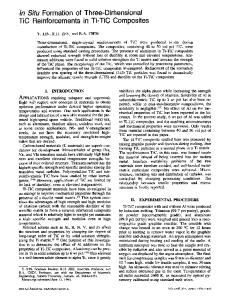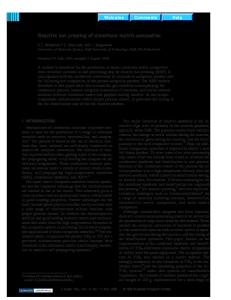In situ synthesis of TiC particulate-reinforced aluminum matrix composites
- PDF / 3,485,910 Bytes
- 8 Pages / 598 x 778 pts Page_size
- 95 Downloads / 497 Views
Particulate-Reinforced Aluminum Matrix Composites TETSUYA NUKAMI and MERTON C. FLEMINGS Particulate TiC-reinforced aluminum composite specimens were processed by compacting a mixture of titanium, carbon, and aluminum powders into preforms that were infiltrated with molten aluminum and subsequently heated in a differential thermal analyzer to about 1573 K under argon atmosphere. The onset of formation of TiC particles began at about 1150 K by reaction of TiA13 with A14C3. Subsequent formation of TiC particles at higher temperatures to approximately 1265 K occurred by direct reaction of carbon with TiA13. Above this temperature, the TiC particles coarsened with increasing temperature from an initial size of about 0.15/xm. TiC particles were also produced in preforms that were not infiltrated; however, the presence of liquid aluminum in infiltrated specimens inhibited particle agglomeration and sintering. Infiltrated preforms could, therefore, serve as excellent "master alloys" for subsequent dilution in an aluminum melt and processing of metal-matrix composites (MMCs) reinforced with submicron TiC particulates.
I.
INTRODUCTION
T O date, only a limited number of production applications exist for metal-matrix composites (MMCs). In 1982, the Toyota Motor Corporation (Shizuoka, Japan) first fabricated MMCs for diesel engine pistons, using an A1203 short fiber-reinforced aluminum alloytll and, in 1991, an A1203-SIO2 short fiber-reinforced aluminum alloy for a crankshaft damper pulley.t2] Honda Motor Co. Ltd. (Tokyo, Japan) used dual short carbon and A1203 fiberreinforced aluminum alloys for engine blocks, i31Cost appears to be the main reason for the lack of extensive applications of MMCs, despite their excellent mechanical properties. Recently, ceramic particle-reinforced aluminum MMCs fabricated by in situ processes have been extensively studied due to their potentially low fabrication cost. TiC particulate-reinforced MMCs are very interesting because TiC is thermodynamically stable and enhances the hardness and lightness of the composite. Sahoo and Koczac I41 have synthesized TiC particles in aluminum melts by injecting CH4 gas into A1-Ti alloy melt, and Nakata e t al. LS1 have formed TiC particles by using a reaction between SiC particles and A1-Ti alloy melts. Martin Marietta Corporation (Bethesda, MD) has also developed TiC particle-reinforced TiAU 61 Work at Toyota has shown that TiC composites can be formed in s i t u in preforms of TiC infiltrated with liquid aluminum.[7]
II.
EXPERIMENTAL PROCEDURE
The preforms in this work were made from powders of titanium (99.7 pct purity), crystalline graphite (99 pct TETSUYA NUKAMI, formerly Research Scientist, Massachusetts Institute of Technology, Cambridge, MA 02139, is Assistant Manager, Materials Research and Development Division, Toyota Motor Corporation, Susono, Shizuoka, 410-11 Japan. MERTON C. FLEMINGS, Toyota Professor of Materials Processing, is with the Department of Materials Science and Engineering, Massachusetts Institute of Technology, Cambridge, MA 021
Data Loading...











